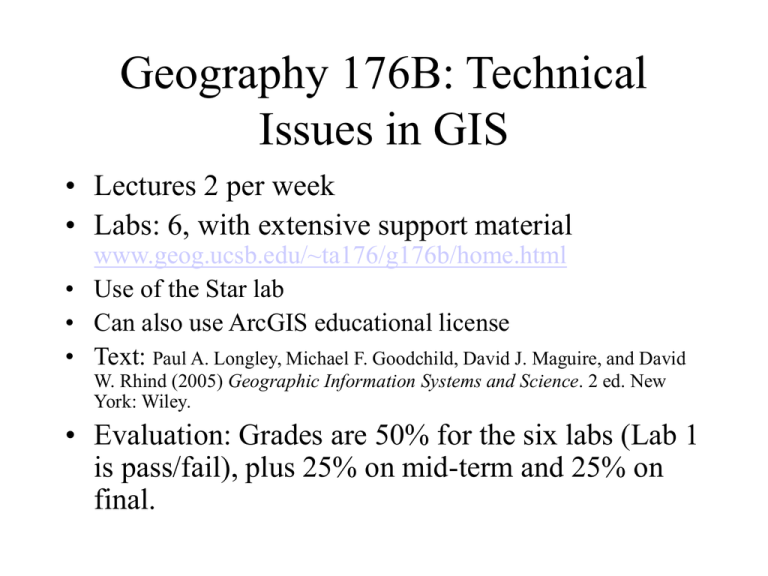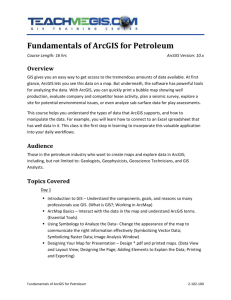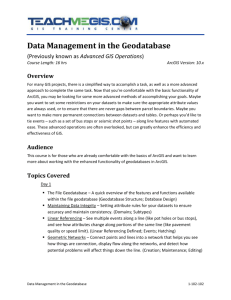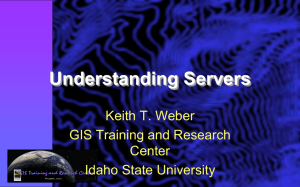A. COURSE OBJECTIVES What kinds of jobs exist in GIS? 1. System
advertisement

Geography 176B: Technical Issues in GIS • Lectures 2 per week • Labs: 6, with extensive support material www.geog.ucsb.edu/~ta176/g176b/home.html • Use of the Star lab • Can also use ArcGIS educational license • Text: Paul A. Longley, Michael F. Goodchild, David J. Maguire, and David W. Rhind (2005) Geographic Information Systems and Science. 2 ed. New York: Wiley. • Evaluation: Grades are 50% for the six labs (Lab 1 is pass/fail), plus 25% on mid-term and 25% on final. What will I learn in Geog 176B? • Build depth on Geog 176A’s breadth • Prior to Mid-term: Learn data modeling and GIS design • After Mid-term: Analysis, management and research issues • Along the way: Some applications • After 176B: 176C Applications of GIS • Goal is to increase your knowledge of GIS to system user level, both theory and practice What kinds of users exist for GIS? 1. System developers: high level of technical skills programmers in C++, Java, Visual Basic: order 1,000 jobs 2. System maintainers: moderate technical skills programmers in UML, Visio, CASE, Visual Basic: order 10,000 jobs 3. System users: modest technical skills, know how to use the tools, familiar with the technical issues , know the application domain, work for governments, corporations, universities, manage others: order 100,000 jobs 4. General public: minimal skills know how to use some tools: order 1,000,000 people 5. Mass consumption: Use Internet-based GIS mapping tools or location systems e.g. Google Earth: 100,000,000 people 6. Benefit from GIS technology: Almost everyone What do you need to know to be a success as a (3) System user? • • • • • • • • • Basic principles that survive software changes How to be a demanding skeptic Demand better documentation Demand/create accurate data that reflect the real world Reliable and accurate results Fixes for bugs What GIS means What are the limitations What (other) operations are possible What about practical training? • • • • • • Software changes often (every 2 years) Always possible to acquire training Hands-on experience reinforces basic principles Encourages you to be a demanding skeptic Encourages thinking about what GIS means E.g. Classic ARC/INFO (Workstation) the workhorse of GIS – – – – Engine behind ArcView Versions 1, 2, 3 Command-line interface Required syntax, difficult to learn and use still many fans ArcGIS 8.0 onward • • • • • several hundred person-years invested complete rewrite, first since 1980 released in 2000 version 7 became ArcInfo Workstation version 8 added ArcInfo Desktop WIMP, wizards • ArcView as a subset ArcGIS 9.0 in 2005 • Now at 9.1 ArcGIS Overview • • • • • Hardware and software (UNIX/Mac) Microsoft NT (2000, XP, etc) Intel hardware "wintel" COM: Component Object Model Microsoft standard for re-usable software components • geographic objects and software objects • any components can be linked • interoperability with any COM-compliant software Example of ArcGIS and Excel working together programmed in Visual Basic for Applications (VBA): ‘Pass Excel the U column vector(vector of known source values)’ While Not pFeat Is Nothing strRow = GetRow(pFeat.Value(0)) ‘GetRow is userdefined strCol = "A" Sheets("Sheet2").Select 'Store vector on Sheet 2 in Column A Range(strCol & strRow).Value = pFeat.Value(intSourceIndex) Set pFeat = pCursor.NextFeature Wend ESRI Data models: how Redlands describes the world • Shapefiles – – – – – points, lines, areas attributes ArcView heritage No topology Relatively open source • Coverages (layers) – – – – areas as boundary networks lines as boundaries of areas points as collapsed areas Classic Arc/Info legacy (includes E00) The Coverage paradigm ESRI’s Field Models • Images • Rasters (Grid: lattice) • TINs triangulated irregular networks surfaces as meshes of triangles Geodatabase • ArcGIS moved to a new model based on object-oriented methods • Objects (e.g. features) have classes • Software is component-based • Geodatabase is a “collection”, so can contain models of different types Geodatabase paradigm Three software components: • ArcCatalog – managing data – data preview – metadata • ArcMap – display, windows, layouts – Cartography, coordinates, projections • ArcToolbox – analysis – some transformations – mostly for coverages ArcGIS Geodatabase Workspace Geodatabase Feature Dataset Feature Class Geometric Network Relationship Object Class Object Class • An object class is a collection of objects in tabular format that have the same behavior and the same attributes. An object class is a table that has a unique identifier (ObjectID) for each record Feature Class • A feature class is a collection of geographic objects in tabular format that have the same behavior and the same attributes. Feature Class = Object class + spatial coordinates Relationship • A relationship is an association or link between two objects in a database. • A relationship can exist between spatial objects (features in feature classes), nonspatial objects (objects in object classes), or between spatial and non-spatial objects. Relationship Relationship between non-spatial objects Water Quality Data Water Quality Parameters Relationship Relationship between spatial and non-spatial objects Water quality data (non-spatial) Measurement station (spatial) Network • A network is a set of edges (lines) and junctions (points) that are topologically connected to each other. • Each edge knows which junctions are at its endpoints • Each junction knows which edges it connects to Introduction to ArcGIS • How data are stored in ArcGIS • Components of ArcGIS – ArcMap, ArcCatalog and ArcToolbox • Extensions of ArcGIS – spatial analyst, geostatistical analyst and 3D analyst Arc Map View and edit data Create maps Analyze data (Geoprocessing) Graphical previews View data (like Windows Explorer) Arc Catalog Tables Metadata Arc Toolbox Map Projections Tools for commonly used tasks Classic ArcInfo v7: Legacy • • • • ArcGIS Workstation Coverage data model Command line interface Unix or NT hidden by ArcInfo Desktop Extensions • • • • • • • geostatistics logistics analysis and modeling with rasters Networks Surveying/CAD Military etc Application environment • 2,000 reusable software objects (COM) • Programmable in Visual Basic for Applications (VBA) • Data modeling with Unified Modeling Language (UML) • Model builder extension • Visio model: ESRI “templates” Transportation model Model detail: UML Description Building an application • Define a schema • What objects are important to my application? • Build an ontology • Create the schema's tables using ArcGIS wizard • Populate the tables • Go to work Tom Gruber’s Definition • ontology is a specification of a conceptualization. • A description (like a formal specification of a program) of the concepts and relationships that can exist for an agent or a community of agents • For GIS, a set of geographical objects with their models and relations • Critical for interoperability Example: Land Use Maps • Map 1: – 20 classes – Wetlands one class – Digitized polygons with 40 acre MMU • Map 2: – – – – 75 classes Wetlands specified by species: Forested/Non-Forested Second layer of permanent/seasonal Values assigned as classes to cells



